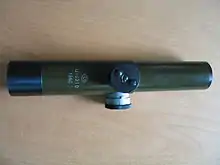PU scope
The PU scope (ПУ, прицел укороченный, 'Scope short-cut' in comparison to PE/PEM telescopic sight) is a 3.5×21 telescopic sight of Soviet manufacture, widely used since 1940 on the SVT-40 rifle for which it was originally designed and since 1942 on the Mosin–Nagant rifle. Before converting the PU for Mosin–Nagant Model 1891/30 sniper rifles these rifles used 3.87×30 PE(M) telescopic sights, a Soviet-made copy of a German Zeiss design, while later rifles used smaller, simpler, and easier-to-produce 3.5×21 PU telescopic sights.[1] The PU telescopic sight has a fixed at 3.5 power magnification. The reticle could be adjusted vertically for range, and the elevation turret is graduated from 0–1,300 m (0–1,422 yd) in 100 m (109 yd) increments. The bullet drop compensation (BDC) adjustment in the elevation turret is free spinning under grease friction. The windage adjustment turret of the telescopic sight features more conventional click adjustments in milliradian increments. The design turned out to be so successful and in demand that production was not stopped after World War II and the sight was converted for and used on other small arms.[2]

It is claimed that the Soviets attempted to create a 6× version of the telescopic sight though this has been refuted. An aftermarket objective lens known as the PU Magnifier (PUM) is able to give the PU telescopic sight a 6.5× power.
Technical specifications
- Magnification: 3.5×
- Objective diameter: 21 mm
- Field of view: 4° 30′
- Exit pupil: 6 mm
- Eye relief: 72 mm
- Limiting optical resolution: 17 SOA
- Weight: 0.27 kg
- Length: 169 mm
Gallery
 The PU 'German style' reticle
The PU 'German style' reticle Russian SVT-40 semi-automatic battle rifle with PU 3.5×21 sight
Russian SVT-40 semi-automatic battle rifle with PU 3.5×21 sight Russian Model 1891/30 sniper rifle with PU 3.5×21 sight
Russian Model 1891/30 sniper rifle with PU 3.5×21 sight Hungarian M/52 siper rifle with PU 3.5×21 sight
Hungarian M/52 siper rifle with PU 3.5×21 sight
External links
| Wikimedia Commons has media related to PU rifle scope. |
